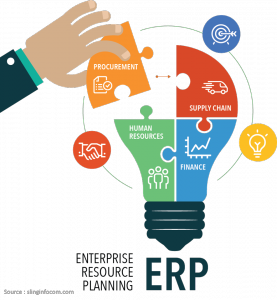Whether it's a first site or a redesign, one of the central issues facing e-commerce sites remains the connection between the website and the company's ERP/CRM/PIM systems the implementation and synchronization of different ERP and management software packages (PIM-Products Information Manager, ERP - Enterprise Resource Planning...) with the merchant site itself.
Very often, online sales are a complementary channel to existing physical stores. The management of web orders is added to those of other points of sale. The link between a software package and an e-commerce solution is therefore essential if you wish to have up-to-date stock and prices on your site, or distribute your products on marketplaces such as Amazon.
All the more so as each activity, and therefore each site, has its own specificities. Requests and needs n will vary depending on your audience (B2B, B2C), your product buying cycles, your sales strategy...
will vary depending on your audience (B2B, B2C), your product buying cycles, your sales strategy...
Identify the company's needs in terms ofinterconnectivity of its software packages is therefore the first step in defining the functionalities expected of your network and the connectors to be installed (what is the current structure of the network, which software will have priority within it, how often to update data, etc.).
Once your needs have been defined and you've prioritized your ERP and software packages, you'll be faced with a number of questions concerning the connection between these packages and your e-commerce solution. At Soledis, we start by getting to know your specific sector and the key functions of your business. We design your ERP link taking into account your specific needs. Find out more about our ERP connectors on our dedicated SoConnector by Soledis website.
Our experience in business analysis enables us to understand and anticipate the most frequent problems. We have selected 5 major themes that come up most often as a result of this analysis.
Order management
An e-commerce site does not always allow orders to be processed internally (too large volumes...). They are very often handled separately via a ERPwith its greater processing capacity. This considerably streamlines information processing, by synchronizing orders, stock management and delivery, as well as establishing links with invoicing and payments.
This process can be optimized by linking the ERP directly to the merchant site through a connector. The ERP thus becomes a "brick" that complements the site's existing structure and enhances its performance. It can also integrate off-site orders, to provide an overview of order volumes and related inventory management.
This means that changes to the ERP are passed on much more quickly to the site and the adjoining product distribution outlets, keeping them up to date.
Our customers
This is the heart of your business. Visit customer data synchronization at the heart of the user experience A change in information must be passed on in real time to all the company's departments.
Customer relations can be tracked using a variety of media. ERP enables fairly comprehensive contact management, which can then be synchronized with dedicated software packages to ensure more sustained follow-up.
For example, a change of name or address entered in the customer area must be synchronized with the CRM or ERP management system to update the contact record. In the same way, a modification recorded in the CRM or ERP concerning a delivery address (given over the phone, for example) must be able to be updated on the customer's account on the e-commerce site.
CRM becomes a new "brick" that complements the e-commerce site. Synchronization keeps customer data up to date, with no need to switch or extract data from the software package or website.
Products and inventories
How does your e-business manage its product repository and inventory?
If you have a ERP, c it contains the raw product information. Depending on the size of your catalog and the evolution of your site, the installation of a PIM will enable the management of more detailed product sheets. The PIM then becomes the center of product information.
it contains the raw product information. Depending on the size of your catalog and the evolution of your site, the installation of a PIM will enable the management of more detailed product sheets. The PIM then becomes the center of product information.
To ensure the smooth exchange of data, it is essential to interface the PIM with the e-commerce solution. Depending on your structure, you may also be able to interconnect the PIM with the ERP, but it would be preferable to keep a priority referent for all your software.
Inventory management is a sensitive issue. If you don't have a stock of products dedicated to online sales, the synchronization between physical and web stocks is essential. ERP allows you to centralize all this data (on-site and off-site) for a better overview of inventory, managed in real time. If you sell your products on marketplaces such as Amazon, regular updating (ideally several times a day) is vital to ensure that you don't end up with orders that can't be fulfilled for lack of physical stock.
Invoice and payment
An essential component is the mastering invoice numbersThese should follow each other as orders come in. Setting up a linking ERP and e-commerce solutions allows you to centralize the production of invoices, whether they originate from a store or a site. This centralization also enables invoices to be harmonized with each other.
Payment management depends largely on the type of customer. For low-value BtoC purchases, payment management is handled by the e-commerce sites' credit card modules.
The situation becomes more complicated when it comes to sales to professionals. Transfers within 60 days and bills of exchange require deferred payment. ERP makes it possible to track these exchanges, but above all to manage customers with "customary payment terms". Connected to your e-commerce siteIt keeps this information up to date by transmitting it directly to the accounts concerned.
Public and private prices
Depending on the field of activity, prices can evolve and vary from one customer to another. One solution is to offer public prices in plain text, accessible from the front-end, and to propose the corresponding prices to the customer once he or she has logged in.
There are several solutions for implementing this price managementThis is a complex task, given the volumes to be generated and processed during basic calls.
- Import prices regularly and let the website respond to customer requests. While this solution is efficient in terms of queries, it remains asynchronous, since prices or customer data will not necessarily be up to date when the order is placed.
- Integrating ERP intelligence directly in the e-commerce site allows the site to determine prices on its own. In addition to the lack of control over these prices, the risks of error are high, development expensive and maintenance difficult.
- Interfacing ERP and e-commerce solutions remains the simplest way of providing public and private prices; the merchant site queries the ERP for prices, and these are given without risk of obsolescence. Great care must be taken with this webservice, which can place heavy demands on the server.
ERPs have long been the focal point for the creation of this network, around which 
the site's other functions. However, this concept is increasingly being called into question in several respects. ERP is no longer "the only software on board"; other additional tools such as PIM, CRM... have emerged, specializing in areas where they are often more effective than ERP.
The notion of the focal point is also evolving; at the heart of the process is thee-commerce activity in itself, which can be conceived as a modular package. The software used to optimize information processing can then be added to this model via ERP connectors.
LERP/e-commerce site interfacing is above all a considerable time-saver, freeing up resources for higher value-added activities. This interconnection also enables you to consolidate your on-site and off-site results (telephone sales, in-store sales...) for a global view of your business.
Would you like more information? Don't hesitate to contact us. We'll be happy to help. advisor on your project!
 Discover SoConnector, ERP, CRM, PIM and website connector. Automatically transfer data between your management software and your e-commerce platform! Optimize your management of orders, prices, products and customer information.
Discover SoConnector, ERP, CRM, PIM and website connector. Automatically transfer data between your management software and your e-commerce platform! Optimize your management of orders, prices, products and customer information.
